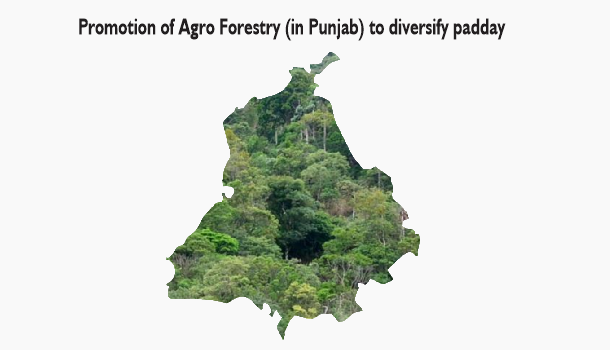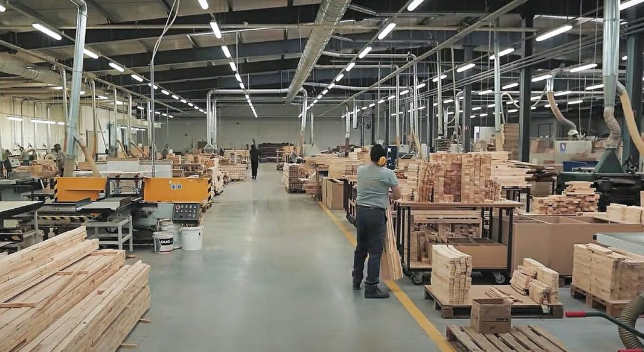
Promotion of Agro Forestry (in Punjab) to diversify paddy
- September 12, 2023
- 0
Lessors are often reluctant to provide land on long-term leases due to concerns about potential ownership loss or changes in land-use patterns.
3 Concerns over adoption of agroforestry:
However, the adoption of agroforestry practices in Punjab faces some challenges. Challenges are present both at the farmer’s end as well as from industry’s end.
1. No provision for annual income to small farmers during gestation:
One major concern for farmers is the long gestation period of 5-7 years for tree crop harvest, which poses a cash flow issue. Unlike annual crops that provide regular income, the initial years of agroforestry may not yield significant earnings. Intercropping may offer some income during the initial 1-2 years, but farmers face limited or no earnings in subsequent years, creating uncertainty.
2. Extreme price volatility reducing confidence in the industry:
The agroforestry sector experiences significant price volatility due to the lengthy gestation cycle and planting behavior. During the year 2014, an excess supply of timber led to a crash in prices. Consequently, many farmers stopped/reduced planting trees, leading to a surge in demand. Such price fluctuations undermine farmers’ confidence in the industry and makes them hesitant to invest their resources and efforts into agroforestry. This uncertain growing pattern also creates ambiguity for the wood-based industries.
The wood-based industry has been grappling with a persistent shortage of supply over the past few years, and this issue has become particularly prominent this year. Consequently, some units have been forced to shut down entirely, while others are operating at low levels of utilization. This scarcity of supply not only results in high manufacturing costs for the industry but also compels them to procure materials from other states, leading to increased transportation and input expenses. As a result, the wood-based industries in Punjab face significant challenges in competing with their counterparts in other northern states and even with industries in the southern region. This situation poses a hurdle to the growth and competitiveness of the current wood-based sector in Punjab. Hence, stabilizing prices is the need of the nour.
3. Lack of awareness on incomes and farming practices:
Farmers often lack awareness of the potential incomes and farming practices associated with agroforestry. It has been observed that transitioning from traditional crop-based farming to agroforestry can provide farmers with 1.2-1.5 times the annual income generated from paddy/wheat cropping cycle. Additionally, carbon credits can further bolster their earnings. However, the lack of extension services and information dissemination regarding tree cultivation and associated benefits hampers farmers’ understanding and interest in adopting agroforestry. Furthermore, misconceptions regarding soil impacts, especially due to eucalyptus trees, add to their reluctance.
4. Limited availability of genetically superior planting material (saplings/seeds):
The shortage of high yielding clonal varieties and genetically improved seedlings is another factor hindering the adoption of agroforestry. Farmers require access to quality planting material (saplings/seeds) that offer higher yields, disease resistance, and other desirable traits. However, there is currently no robust system in place for certification of planting material required for agroforestry, limiting the availability of genetically superior planting material.
5. Limited long-term land tenancy further restricts potential:
A significant proportion of farmers in Punjab lease their land rather than self-cultivation.
However, agroforestry, with its long gestation period, poses challenges for farmers who operate on short-term lease agreements (typically 1 year). Lessors are often reluctant to provide land on long-term leases due to concerns about potential ownership loss or changes in land-use patterns. This limitation further restricts the potential for farmers to engage in agroforestry practices. During interactions with tree-growing farmers in last few months it has come to notice that some of the farmers want to take up the agroforestry on leased farm land however, the apprehensions/reluctance of those farmers towards long term and legally valid lease is restricting the potential tree growers. Here the issue of small farmers welfare and legalities involved needs special attention.
Addressing these concerns requires targeted efforts, such as creating income support mechanisms, promoting stable pricing mechanisms, conducting extensive awareness campaigns, improving availability of quality planting material, and exploring innovative solutions for long-term land tenancy.
Strategic Recommendations to Increase Acreage in Agroforestry
A comprehensive strategy and implementation plan was discussed with both farmers and the industry representatives on 23rd June 2023 at PAU, Ludhiana. An in-principle agreement on the action steps has been reached.
To ensure the agreement is honored by both parties, several deterrents can be defined. The deterrents to be placed on for industry are, either monetary or a penalty on licenses depending on the extent and frequency of the violation. If a farmer violates, they may become ineligible for agroforestry related benefits announced henceforth. Such measures aim to foster trust, accountability, and adherence to the terms of the voluntary agreement and should be viewed in that spirit.
5.6 Enforcement of Mandi laws
Incentivizing the development of agroforestry-based supply chains and markets is crucial to ensure farmers’ produce finds a fair and profitable market. To this effect, the existing mandis need to made operational. Currently, timber sales occur outside the mandis, leading to intermediaries charging commissions from farmers. Establishing a transparent system within mandis and enforcing the mandi laws will address this issue, ensuring proper tracking of supply and demand, issuance of J forms, and fair price realization for farmers.
5.11 Lease paddy growing panchayat land for agroforestry
As a measure to support the growth of agroforestry is to allocate the panchayat land, currently utilized for paddy cultivation, for agroforestry purposes. Panchayat land can be made available on long-term leases, enabling farmers who do not possess their own landholdings or willing industries to participate in agroforestry activities. This inclusive approach would not only promote sustainable land utilization but also encourage the involvement of a wider range of farmers, contributing to the expansion of agroforestry practices. By utilizing panchayat land for agroforestry, the wood-based industries in Punjab would have improved access to raw materials, potentially reducing manufacturing costs, enhancing competitiveness, and ensuring a more sustainable and resilient future for the sector.
5.12 Direct purchase of timber from farmers
Enabling direct timber purchase from farmers is crucial to support wood-based industries and overcome the constraints imposed by mandi board rules. Currently, these rules hinder industries from establishing long-term agreements with farmers, resulting in an unstable and unsustainable supply chain. While the farmers and industries can directly get into an agreement, Arthiyas can still play a role in executing agreement by supporting farmers and industries in felling and transportation. This can be agreed upon and mentioned in the agreement.
Online sales initiatives that could streamline the process are also hindered by mandi board rules. Therefore, it is necessary to modify the existing rules to facilitate direct purchases between industries and farmers, while clearly defining the role of Arthiyas. Such modifications will lead to more efficient and transparent transactions, benefiting both parties involved.
By creating an enabling environment for direct timber purchase, wood-based industries in Punjab can establish stronger relationships with farmers, ensuring a stable and sustainable supply of timber for the industries’ growth and development.
6 Summary of recommendations:
The recommendations put forward in the context aim to address the challenges faced by farmers in adopting agroforestry practices and promote its successful implementation in Punjab. The primary focus is on ensuring a fair and stable remunerative price for agroforestry products, which includes income parity with paddy. To achieve this, a voluntary agreement between farmers and the wood-based industry is proposed with a provision of fair remunerative price to the farmers, supported by a dedicated government body to oversee pricing and dispute resolution.
To support farmers during the gestation period of agroforestry, an annuity model is suggested, wherein farmers can obtain loans at low-interest rates from banks or financial institutions. Additionally, the establishment of essential infrastructure, such as soil testing labs, demonstration farms, and a robust e-timber portal, will facilitate smooth implementation and communication between stakeholders.
To further incentivize agroforestry, additional income opportunities via carbon credits and insurance coverage are recommended. The involvement of research and educational institutions, particularly Punjab Agricultural University (PAU), is vital to provide guidance and research initiatives to enhance the productivity and sustainability of agroforestry systems.
To ensure effective governance, it is essential to clarify ownership and jurisdiction between the Forest Department and Agriculture Department.
Moreover, government schemes offering subsidies for fencing, solar pumps, canal water release, drip irrigation systems, and free saplings can provide much-needed support to farmers in their agroforestry journey.
By implementing these recommendations, Punjab can create an enabling environment for farmers to transition from traditional paddy cultivation to agroforestry. This will not only enhance farmer income and livelihoods but also contribute to environmental conservation and foster a sustainable and resilient agricultural landscape in the state.


































































